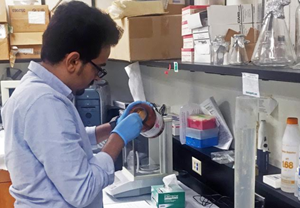
Ph.D. student Rebecca Lichtler prepares hydrocarbon solutions for toxicity studies in cultured cells. (Photo by Charles Miller)
Hydrocarbons associated with oil spills can have harmful effects on humans and organisms, yet little is known about the specific compounds that contribute to toxicity. The ability to identify and quantify oil’s key toxic compounds will help improve predictions of future spills’ effects on human health and marine ecosystems.
The Gulf of Mexico Research Initiative recently awarded Dr. Charles Miller a grant to identify toxic compounds within fresh and weathered Deepwater Horizon crude oil. Miller’s team hypothesizes that a relatively small group of chemicals accounts for most of oil’s toxicity and hopes to identify these oil compounds that are crucial to understanding toxicity.
Oils from different sites and sources vary in composition and toxicity, and oil components change radically with time and weathering. There are sixteen polycyclic aromatic hydrocarbon (PAH) compounds that the Environmental Protection Agency has identified as reference compounds for use in environmental studies. Researchers will explore oil compounds not included in the sixteen reference PAHs to expand our knowledge about the toxicity of these less-studied oil compounds.

Ph.D. student Ahmad Alqassim prepares a chemical solution for cellar analysis. (Photo by Charles Miller)
“There are oil compounds that are more prevalent and complex than the sixteen reference compounds, but they have been studied either very little or not at all,” said Miller. “There are thousands of chemicals in oil that we have no toxicity data for at all – we don’t know what they do.”
Miller’s team will conduct genetic assays to identify oil compounds that activate the aryl hydrocarbon receptor (AhR), a protein in all human cells that can signal the expression of genes related to serious adverse health effects, including cancer. They will separate crude oil samples into fractions that will each be combined with human stem cells to identify those that activate the AhR. The researchers will then refractionate the identified fractions into smaller groups of chemicals and run them through the assay again. They will repeat this process to isolate individual compounds responsible for oil toxicity.
Miller hopes this research will provide important guidance into which oil compounds should be assessed in order to gauge a spill’s toxicity. “Some spills are more toxic than others, and we don’t always know why that is,” he said. “If we knew which chemicals to watch for, it could help estimate how toxic a spill may be.” Tracking these toxic compounds during future spills will help researchers and responders better understand the severity and persistence of the potential risks associated with oil contamination.
This project’s researchers are Charles Miller, Jeffery Wickliffe, and Mark Wilson of the Tulane University School of Public Health and Tropical Medicine and Edward Overton of the Louisiana State University Department of Environmental Sciences. Their project is Toxicological Properties of Specific Aromatic Hydrocarbons Isolated from Fresh and Aged Crude Oil from the Deepwater Horizon Spill.
************
The Gulf of Mexico Research Initiative (GoMRI) is a 10-year independent research program established to study the effect, and the potential associated impact, of hydrocarbon releases on the environment and public health, as well as to develop improved spill mitigation, oil detection, characterization and remediation technologies. An independent and academic 20-member Research Board makes the funding and research direction decisions to ensure the intellectual quality, effectiveness and academic independence of the GoMRI research. All research data, findings and publications will be made publicly available. The program was established through a $500 million financial commitment from BP. For more information, visit http://gulfresearchinitiative.org/.
